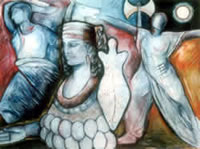
Diana/Artemis, Queen of the Amazons (oil, 1997)
I was visiting the British Museum in London with a friend when we found that there was a special exhibition of marble reliefs from Greece relating to a war between the Amazons and Satyrs, beings who were half man and half horse. There was a whole room lined with these extraordinary, powerful images of strong women in battle, bodies almost ecstatic, reckless, great movements and energies released – some of the most expressive images of women I have ever seen, far from the static, placid Madonnas of Europe. Diana/Artemis had her temple in Ephesus on the coast of Turkey which in legend was built by Amazon women warriors who were said to have founded many great cities. Artemis is a Goddess from as far as the shamanic north of Russia. She was a Goddess and protector of women. She was many-breasted and although a “virgin”, she gave birth to all of creation. She had a black meteorite in her crown and her temple was one of the wonders of the ancient world. It was here in Ephesus during a Church council in the fourth century that Maria was declared the Queen of Heaven and also divine. The Ephesians would have nothing less!
Until recently it was thought (by patriarchal historians) that the Amazon horse women did not exist but now there is more and more evidence as graves are found in Russia of women buried with their weapons. Great shaman women covered in magical tattoos and wearing high headdresses are also being discovered.
The archaeologist Jeannine Davis-Kimball of the American-Eurasian Research Institute and Centre for the study of Eurasian nomads has written an exciting book called “Warrior Women: An Archaeologist’s Search for History’s Hidden Heroines“. She works closely with Russian speaking archaeologists in Kazakstan, Ukraine and Southern Siberia in the Altai mountains where the astounding grave of a tall warrior priestess or ruler of her people covered in fantastic tattoos and wearing a three feet high headdress was discovered when the permafrost melted with the climate change. Many Iron Age Caucasian nomadic tribes such as the Saka, Scythians, Sauromatians and Sarmatians of the Euro-Asian steppes, near the Black and Ural seas and the Don and Volga rivers, were woman-led and the majority of the Kurgans (houses of the dead) or great burial mounds often containing gold treasures, were those of powerful women, some of whom were both horse-riding warrior women as well as shaman-priestesses and were buried with swords and daggers as well as portable altars, bronze mirrors and other magical implements.